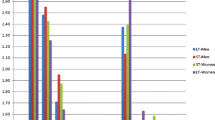Abstract
While it is common for gender to be included as a predictor variable in studies of sexuality, this is not the case for other demographic variables. This study examined the predictive value of gender, along with other demographic variables, including age, marital status, education, religiosity, and geographic region using data from a national survey of Canadian adults over the age of 18 (N = 1479). The survey was conducted by the COMPAS survey organization using computer assisted telephone technology. The outcome variables examined included frequency of sexual thoughts, oral sex, age at first intercourse, number of sexual partners, and casual sex intentions. For each of the variables, men were more sexually permissive and more sexually active than were women. Other demographic variables increased the explanatory power of the models but gender still remained a significant predictor of sexual attitudes and behaviors despite statistical control for other demographic variables. The findings demonstrate the influence of gender on sexuality but also illustrate the value of taking into account other demographic variables when analyzing gender differences in sexuality.
Similar content being viewed by others
References
Barrett, M. (2004). Oral sex and teenagers: A sexual health educator's perspective. Canadian Journal of Human Sexuality, 13(3–4), 100–197.
Barrett, M., King, A., Levy, J., Maticka-Tyndale, E., McKay, A., & Fraser, J. (2004). Canada. In R. T. Francoeur & R. J. Noonan (Eds.), The Continuum complete international encyclopedia of sexuality (pp. 126–181). New York: Continuum.
Baumeister, R. F. (2000). Gender differences in erotic plasticity. Psychological Bulletin, 126, 347–374.
Baumeister, R. F., Catanese, K. R., & Vohs, K. D. (2001). Is there a gender difference in strength of sex drive? Personality and Social Psychology Review, 5, 242–273.
Bibby, R. W. (2001). Canada's teens: Today, yesterday and tomorrow. Toronto: Stoddart.
Boyce, W., Doherty, M., Fortin, C., & Mackinnon, D. (2003). Canadian youth, sexual health and HIV /AIDS study: Factors influencing knowledge, attitudes and behaviors. Council of Ministers of Education, Canada.
Boyle, F. M., Dunne, M. P., Purdie, D. M., Najman, J. M., & Cook, M. D. (2003). Early patterns of sexual activity: Age cohort differences. Australian International Journal of STD and AIDS, 14, 745–752.
Brown, N. R., & Sinclair, R. C. (1999). Estimating number of lifetime sexual partners: Men and women do it differently. Journal of Sex Research, 36, 292–297.
Brym, R. J. (1986). Regionalism in Canada. Toronto: Irwin.
COMPAS Polling (1998). [Modern life survey of the Canadian adult population]. Unpublished raw data.
Dunne, M. P., Martin, N. G., Bailey, J. M., Heath, A. C., Bucholz, K. K., Madden, P. A., et al. (1997). Participation bias in a sexuality survey: Psychological and behavioral characteristics of responders and non-responders. International Journal of Epidemiology, 26, 844–854.
Hyde, J. S. (2005). The gender similarities hypothesis. American Psychologist, 60, 581–592.
Laumann, E. O., Gagnon, J. H., Michael, R. T., & Michaels, S. (1994). The social organization of sexuality: Sexual practices in the United States. Chicago: University of Chicago Press.
Lefkowitz, E. S., Meghan, M. G., Shearer, C. L., & Boone, T. L. (2004). Religiosity, sexual behaviors and sexual attitudes during emerging adulthood. Journal of Sex Research, 41, 150–155.
Lottes, I. L. (1993). Nontraditional gender roles and the sexual experiences of heterosexual college students. Sex Roles, 29, 645–669.
Maticka-Tyndale, E., Barrett, M., & McKay, A. (2000). Adolescent sexual and reproductive health in Canada: A review of national data sources and their limitations. Canadian Journal of Human Sexuality, 9, 41–65.
McKay, A. (2004). Oral sex among teenagers: Research, discourse and education. Canadian Journal of Human Sexuality, 13(3–4), 201–203.
Mercer, C. (2001). National Survey of Sexual Attitudes and Lifestyles II, 2000. National Centre for Social Research. Department of Primary Care and Population Sciences, Centre for Sexual Health and HIV Research, University College London.
Meston, C. M., Heiman, J. R., Trapnell, P. D., & Paulhus, D. L. (1998). Socially desirable responding and sexuality self-reports. Journal of Sex Research, 35, 148–157.
Morrison-Beedy, D., Corey, M. P., Kowalski, J., & Tu, X. (2005). Group based HIV risk reduction intervention for adolescent girls: Evidence of feasibility and efficacy. Research in Nursing and Health, 28(1), 3–15.
Muehlenhard, C. L. (1988). Nice women don't say yes and real men don't say no: How miscommunication and the double standard can cause sexual problems. Women and Therapy, 7, 95– 108.
Oliver, M. B., & Hyde, J. S. (1993). Gender differences in sexuality: A meta-analysis. Psychological Bulletin, 114, 29–51.
Peplau, L. A. (2003). Human sexuality: How do men and women differ? Psychological Science, 12, 37–40.
Peruga, A., Kofie, V. Y., & Martinez, R. M. (1993). Who won't tell: Predictors of refusal to report number of sex partners. International Journal of STD & AIDS, 4, 86–89.
Schwartz, P., & Rutter, V. (1998). The gender of sexuality. Thousand Oaks, CA: Pine Forge Press.
Statistics Canada. (2002). 2001 census: A profile of the Canadian population: Where we live. [Catalogue #96F0030XIE01001].
Statistics Canada (2005). Study: Is postsecondary access more equitable in Canada or the United States? Available at www.statcan.ca/Daily/English/050315/d050315c.htm.
Trudel, G. (2002). Sexuality and marital life: Results of a survey. Journal of Sex and Marital Therapy, 28, 229–249.
Author information
Authors and Affiliations
Corresponding author
Rights and permissions
About this article
Cite this article
Fischtein, D.S., Herold, E.S. & Desmarais, S. How Much Does Gender Explain in Sexual Attitudes and Behaviors? A Survey of Canadian Adults. Arch Sex Behav 36, 451–461 (2007). https://doi.org/10.1007/s10508-006-9157-9
Received:
Revised:
Accepted:
Published:
Issue Date:
DOI: https://doi.org/10.1007/s10508-006-9157-9




